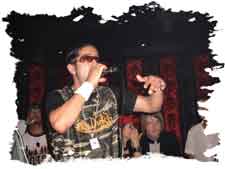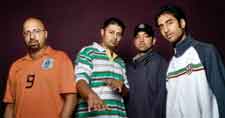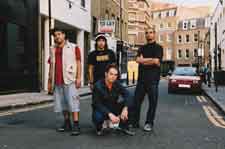Life
Desi Hip Hop

Hip-hop has become as vital to the cultural identity of young Desis as faith and language were to their parents.
|
On a humid summer night in New York City, Chirag Menon is clutching a microphone on a makeshift stage in the basement of Columbia University’s Lerner Hall, taking stock of the packed audience of South Asian American journalists, hip-hop enthusiasts and the truly curious.
Menon – aka Chee Malabar – surveys the eclectic crowd and politely thanks them for attending. But once the music is cued, the smile from Malabar’s face disappears, and he delivers passionate and forceful rhymes baring the depths of his brownness. Even those who grew up listening to Ravi Shankar, Lata Mangeshkar, the Beatles and other more mellow fare cannot help but swing their bodies and nod their heads in rhythm to Malabar. After his politically charged set, some of the older South Asian Americans, flushed with excitement, rush to the stage and thank him profusely for his appearance. Welcome to Desi hip-hop’s coming out party. What started as a small movement more than a decade ago, led by the bhangra-infused stylings of UK rapper Apache Indian and New York spinster DJ Rekha, has emerged into an international phenomenon for hip-hop listeners and a legitimate money-maker for Desi artists and their labels. Hip-hop, it seems, has become as vital to the cultural identity of young Desis as faith and language were to their parents. “Hip-hop has provided an important outlet for the expression of South Asian American identity,” says Ajay Nair, a professor at the University of Pennsylvania who teaches a class on South Asian Americans and hip-hop and is currently co-editing an anthology on the subject. “We no longer need to succumb to the narrow definitions of South Asian Americanness constructed for us. Hip-hop allows us to define the world as we see it.” As a generation of South Asian Americans look to find their voice, hip-hop has become an expression of choice for those who feel alienated and frustrated by racism, classism and all the other -isms common to disaffected youth. But while many vented their frustrations vicariously by listening to mostly African American performers 10 years ago, a new group of Desis is taking the microphone and letting the world hear their perspectives.
These artists have emerged as the vanguard of the Desi hip-hop generation, taking the best qualities of South Asian identity and incorporating them into their lyrical expressions. Filmmaker and MTV Desi producer Raeshem Nijhon, whose documentary Brown Like Dat explores Desis in hip-hop, says the convergence of South Asian and hip-hop culture should come as no surprise. “[Hip-hop] has become so ever present in American youth culture that it has become a part of the pop culture fabric in an undeniable way,” she says. “Desis…are influenced by its presence – music, clothing, lifestyle. I think some Desis connect in a more personal way, creating a bridge between their experience as minority in the U.S. with hip-hop’s frustrated roots while others embrace it as part of their experience as youth in America.” Whatever the connection, hip-hop has become inextricable to Desi youth, especially to those who have rebelled against the idea that there are only a certain number of acceptable professions for people of South Asian descent. As Nair notes, hip-hop has influenced many young South Asian Americans into social and political activism, life paths their parents might have viewed as unthinkable a generation ago. Rapping for a cause, bound by identity One example of a South Asian American using music to push a socially and politically conscious message is Malabar, who has been rapping for the better part of a decade. Malabar, who makes up half the underground rap duo The Himalayan Project, recently released Oblique Brown, a rallying cry for black and brown Americans to fight against racism and oppression.
Malabar, who was born in India, says he became attracted to hip-hop because it articulated his feelings of alienation and anger at being a minority in the United States. As a budding rapper, he soon started recording songs to vent his frustrations and political views. “The first few tapes I made definitely gave me heart to continue making music since the people who heard it were very supportive,” he says. “I just kept going forward with it and decided to make it my life.” Malabar is among a group of young Desi hip-hop artists making their rounds in the hip-hop underground and getting their music spread among South Asian American music aficionados. He and artists such as The1Shanti, MC Kabir (the son of Nobel Prize winning economist Amartya Sen) and D’Lo (a Sri Lankan-American woman featured on the nationally acclaimed Def Poetry Jam) follow groundbreakers Karmacy (the four-man group known for rapping in English, Hindi, Spanish and Gujarati) and the world renowned DJ Rekha, who last year was named among the 10 most influential South Asians in America by Newsweek. Though Rekha, Karmacy, Punjabi MC and Apache Indian have blended South Asian and hip-hop music, Malabar and others have tried to make a name for themselves as rappers first. Malabar admits the term “Desi rapper” has been a disservice to his career.
Malabar believes his music speaks to his experiences, and that he should be judged as an artist, not as a Desi who raps. Nijhon agrees, saying that South Asian Americans who are part of the hip-hop culture are unfairly categorized for trying to co-opt African American identity. “It is important to remember that South Asians involved in hip-hop are not trying to be black, as hip-hop was born in Black communities,” Nijhon says. “They are artists who have found their identity in that art form, and are using it to express their experiences and messages.” Some rappers of South Asian descent have found that marketing their identity in their music can lead to commercial success, as in the case of The1Shanti. The North Carolina native has performed hip-hop since age 8 and now enjoys international success, cracking the U.K. Billboard charts. The1Shanti, who has performed with mainstream rappers such as Lil’ Flip and Young Joc and says he’s been approached to work with A.R. Rahman, used hip-hop as a “survival tactic.” “When I was eight years old, I was picked on…bullied quite a bit by other kids,” he says. “It was probably because my mother used to send me to school dressed in suits.” Once he began rapping, the kids stopped bullying, afraid of his verbal response. “Yeah, you could beat me to a bloody pulp today, but I could create an image of you in everyone’s minds which would follow you around ’till the end of the school year.” Buoyed by the support of a savvy marketing team and MTV Asia, The1Shanti took his rap skills overseas, where he immediately became a fixture in Indo hip-hop music scene as a member of the hip-hop group, Dum Dum Project. Success as a solo artist in Europe and Asia has fueled his confidence and belief that his new album, India Bambaata, will have major commercial recognition in the American music market. “I’ve become…a skilled South Asian emcee simply because I have been in the industry for as long as I have,” he says. “You can say I’ve got pedigree.” Though he has used his Indian origins to market himself as an artist, The1Shanti agrees with Malabar that hip-hop music has transcended racial identity. “I think good music is good music,” he says. “Music and art in general are the elements of the human experience, which remind us that there’s much more to reality than the sensory data we acquire on the surface.” Nijhon adds that many rappers of South Asian descent no longer feel stigmatized by the idea that hip-hop did not originate in the Desi community and are beginning to claim more ownership of the music. “Hip-hop has roots, but it is also a form of expression significant across race, color and class lines to people who identify with it,” she says. “South Asians and what they do, feel and make defines what it means to be South Asian. When a South Asian makes hip-hop he or she has made it South Asian.” The Next Big Thing The Desi hip-hop movement has grown from the margins of hip-hop culture to the forefront of South Asian American identity in the last decade, but artists and music experts concede that it will take more time before a South Asian American rap artist scores major commercial recognition in the United States. Last year, Sri Lankan Britisher Maya Arulpragasam – known as M.I.A. – roared onto the American music scene with hits such as “Sunshowers” and “Galang,” the latter of which was featured in a Honda car commercial.
Though music critics consider M.I.A. more of a pop artist than a true rapper, her success – coupled with the steady influence of DJ Rekha on American music – has proved to be a catalyst for greater recognition of Desi artists. Rappers such as Malabar, The1Shanti and MC Kabir are now looking to get the same opportunity to shine. Nijhon believes that the toughest decision South Asian American rappers will have to make is between their identity and the potential for the commercial success of their music, especially if the former is a potential burden for the latter to happen. “I don’t think mainstream pop culture is ready to accept a South Asian MC as they are without categorizing them as South Asian and thereby limiting them with their identity,” she says. “Rappers of South Asian descent will have to break in and climb the mountain – getting to a point where they are accepted 3-dimensionally as opposed to a ‘South Asian’ artist expected to rap about Apu (the famous Indian caricature on The Simpsons), bindis, and curry.” However, artists like Malabar argue that the common experiences of minorities, especially since 9/11, could make music produced by Desi artists a galvanizing force for social change. In his single “Oblique Brown,” Malabar makes a scathing attack on American racism and blames conservatives for using 9/11 as the basis of a culture war against racial, religious and ethnic minorities and immigrants. I’m sitting at the station, cuffed to a cell, “There’s no way to measure art by commercial success, but the thing about consumerism is that if you put something in people’s face enough, they will be more likely to check it out,” Malabar says. “I think Oblique Brown the album will appeal to a wide range of folks depending on if they want to take the time and study the content.” Nair predicts commercial recognition and mainstream exposure for Desi American rap artists may come sooner than people think, noting the prevalence of South Asian music in American hip-hop today. “Given the influence of South Asian music in hip-hop today and the general evolution of hip-hop, I think it is only a matter of time before some of the very talented South Asian American MC’s in the underground scene leap into the mainstream,” he says. “But only time will tell.” |





